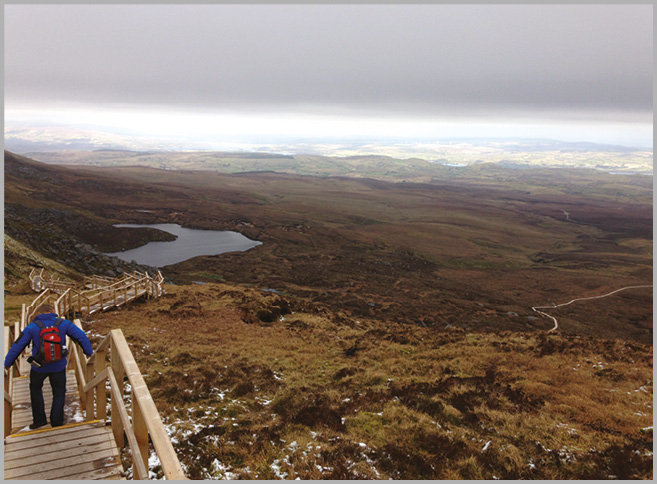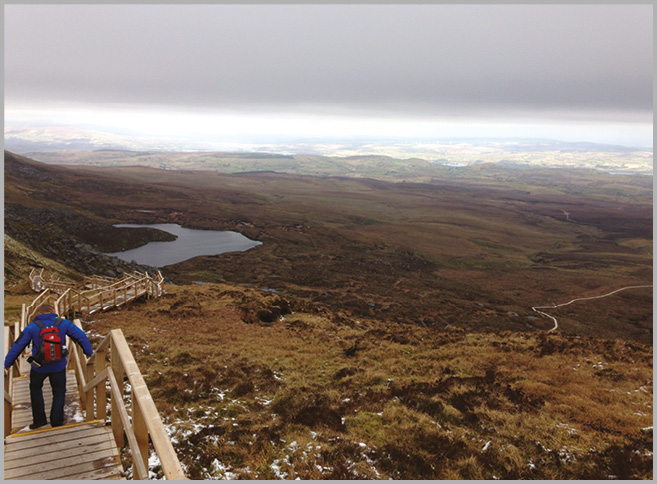Stairway to heaven


A piece of infrastructure built to preserve a bog in County Fermanagh has led to a massive swell of visitor interest in the area but at a potential environmental cost.
The number of visitors travelling to Cuilcagh Mountain in Fermanagh has risen by almost 700 per cent since wooden boardwalk infrastructure was put in place in 2015.
Nicknamed ‘stairway to heaven’, the idyllic views, beautiful surroundings and tranquil isolation of the area have been catapulted into a wider public consciousness thanks to social media and it is now estimated that over 1,000 people visit the spot daily during busy holiday periods.
However, the massive draw of tourists has not been welcomed by all, mainly because the area does not have the necessary infrastructure to support such a vast increase in interest.
Ironically, the wooden boardwalk, now the focus of many visitors’ ‘selfies’ from the mountain’s 666m summit, was built as a means of environmental protection against what was then around 3,000 people per year seeking to climb Cuilcagh. Last year it was estimated that around 24,000 people attempted to reach the summit.
It was built with funding provided by the European Union through the INTERREG IVA Border Uplands Project managed by the Special European Union Programmes Body and the Irish Central Border Area Network with the aim of protecting the blanket bog and restore areas of peatland in the special area of conservation.
The trail, which stretches for around 33km, travels through quiet farmland track before reaching the boardwalk which rises along the mountain face. A rough mountain path then stems up to the wild summit plateau, where an ancient cairn (the remains of a burial mound dating from the Bronze Age 2,500 – 500 BC) stands. The summit of the mountain looks down on the impressive Lough Atona.
However, its popularity has also caused disruption. Local farmers have complained about traffic volumes along the Marlbrough Loop Road, which also accommodates visitors to the popular Marble Arch Caves. While, the designated carpark for the site, only accommodates around 40 cars.
Although there have been calls locally to extend the car park and capture the increase in tourism, Fermanagh and Omagh District Council do not own the surrounding land and would therefore either need to purchase land or require a landowner to develop facilities. A further problem lies in most of the site being designated within an Areas of Special Scientific Interest (ASSI), limiting development potential.
While the Council have acted to introduce interim measures and infrastructure into the busy site, such as traffic management, toilet facilities, signage and leaflets, this increase is estimated to be costing an additional ongoing £3,700 per month. There is also additional staffing costs to redeploy staff from other duties at the Marble Arch Caves or at other Geopark sites, which minutes of a Council meeting revealed were “beyond the budget provision made for the Marble Arch Caves Global Geopark in the year 2017/18.”
At the meeting it was also stated that the Council intends to apply for Preparatory Technical Support under the Rural Development Programme 2014-2020 to scope, plan and develop long-term infrastructure solutions for Cuilcagh.
A council spokesperson says: “To manage the rapid growth in visitors and the associated traffic management issues, Fermanagh and Omagh District Council is working with Transport NI, PSNI, Department of Agriculture, Environment and Rural Affairs and with local land owners to sustainably manage the area to enhancing visitor experience.
“Short term measures that have been put in place include the deployment of additional staff at peak times to direct traffic, provision of additional signage, undertaking minor works to the road and opening of car parking and facilities at the nearby Killykeegan Nature Reserve. Alongside this, Fermanagh and Omagh District Council is actively pursuing longer term solutions to the increased usage of Cuilcagh for recreation. The Council encourages people to visit this stunning landscape but asks that all visitors cooperate fully with parking arrangements and advice and guidance from Council officials.”





